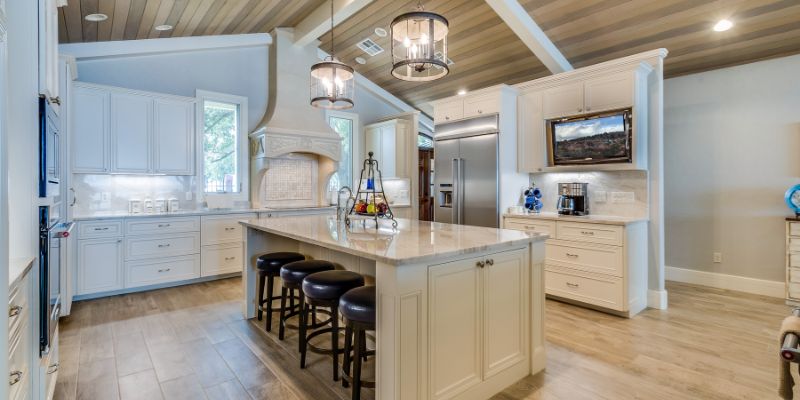Looking for kitchen tile to wood floor transition ideas? There are many options to seamlessly blend different floor materials in your kitchen.
From using a transition strip to creating a visually appealing border, you can find a solution that suits your style and budget. Consider the layout of your kitchen space, the type of flooring materials you are transitioning between, and the overall aesthetic you want to achieve.
With careful planning and the right techniques, you can create a smooth, harmonious transition between your kitchen tiles and wood flooring. Making the transition from kitchen tile to wood floor seamlessly can be a challenge, but with the right ideas, you can create a visually appealing transition that enhances the overall look of your kitchen. This article will explore various creative ideas and techniques to help you achieve a smooth and visually appealing transition between these two flooring materials. Whether you prefer a subtle transition or a more distinct border, there are options to suit every style and budget. Let’s dive into these kitchen tile to wood floor transition ideas to transform your kitchen space seamlessly.
Seamless Kitchen Floor Transitions
When it comes to creating a cohesive and visually appealing kitchen design, seamlessly transitioning between different types of flooring plays a crucial role. A harmonious flow between kitchen tile and wood flooring not only enhances the aesthetics of the space but also improves functionality. Achieving a seamless transition requires careful planning and a keen eye for design. In this article, we will explore the importance of coherent floor design and the challenges in combining kitchen tile and wood flooring.
Importance Of Coherent Floor Design
A well-thought-out floor design in a kitchen can significantly impact the overall look and feel of the space. Seamless transitions between different flooring materials create a sense of continuity, making the kitchen appear more spacious and inviting. Rather than abrupt changes, a coherent floor design ensures that the transition from tile to wood flooring is smooth and visually appealing.
Challenges In Combining Kitchen Tile And Wood Flooring
Integrating tile and wood flooring in a kitchen presents unique challenges, primarily related to differences in thickness, texture, and material properties. Ensuring a seamless transition between these two materials requires careful consideration of factors such as height variations, layout, and the need for transition pieces. Overcoming these challenges is essential to achieving a cohesive and harmonious kitchen floor design.

Kitchen To Wood Floor Transition Ideas
When transitioning from a tiled kitchen floor to a wood floor, it’s essential to seamlessly join the two surfaces while ensuring a smooth, attractive, and safe transition. Explore the following transition ideas for a flawless and visually appealing transition from kitchen tile to wood flooring.
T-molding For Gentle Gradient
T-molding is an excellent option when the height difference between the tiled kitchen floor and wood flooring is minimal. This transition piece is shaped like a “T” and is great for joining two surfaces with a slight elevation difference. It creates a smooth, gentle gradient, ensuring a seamless transition from tile to wood. The durable and stylish T-molding strips come in various finishes and materials, allowing you to find the perfect match for your kitchen and wood floor combination.
Reducer Strips To Adjust Height Differences
When faced with a more significant height variation between the kitchen tile and wood floor, reducer strips are the ideal solution. These transition strips are designed to smoothly even out the height difference, providing a safe and visually appealing transition between the two surfaces. Available in various heights and materials, reducer strips offer a practical and aesthetic solution to address height discrepancies, ensuring a seamless flow from the kitchen to the wood flooring.
Custom Transition Strips For A Unique Aesthetic
For a truly unique and customized transition between your kitchen tile and wood floor, consider opting for custom transition strips. Whether you desire a sleek and modern look or a more ornate design, custom transition strips can be tailored to fit your specific aesthetic preferences. With a wide range of colors, materials, and styles to choose from, custom transition strips allow you to create a one-of-a-kind transition that complements your overall kitchen design and wood flooring, elevating the visual appeal of the space.
Innovative Material Combinations
When it comes to the transition from kitchen tile to wood floor, innovative material combinations can add an exceptional touch to your kitchen design. These creative combinations not only help achieve a smooth and visually appealing transition but also contribute to the overall aesthetic and functionality of the space.
Using A Metal Strip For Industrial Appeal
An excellent way to create a modern and industrial look in your kitchen is by using a metal strip as a transition between the tile and wood flooring. The sleek and minimalist design of the metal strip effortlessly blends with a variety of tile and wood options, offering a seamless transition while adding a touch of urban sophistication to the space.
Incorporating A Glass Tile Border For Modern Kitchens
For a sleek and contemporary transition between kitchen tile and wood floor, consider incorporating a glass tile border. This not only adds a touch of elegance but also creates a visual separation between the two materials. The reflective properties of glass tiles can also enhance natural light in the kitchen, making it appear brighter and more open.
Blending In A Stone Threshold For A Natural Transition
For those aiming for a more natural and rustic transition, blending in a stone threshold can be an excellent choice. The earthy and organic texture of the stone threshold seamlessly connects the tile and wood flooring, creating a smooth and visually appealing transition. This option not only adds a timeless charm to the kitchen but also ensures durability and longevity.
Stylish Solutions In Flooring
When it comes to seamless transitions from kitchen tile to wood floor, it’s essential to consider stylish solutions. From color-matching techniques to transition patterns that integrate kitchen styles, here are some ideas to create a visually appealing and cohesive flooring transition in your kitchen.
Color-matching Techniques
Color-matching techniques play a significant role in creating a harmonious transition between kitchen tile and wood flooring. Coordinating the colors of the tile and wood is crucial. You can opt for wood flooring that complements the dominant color of the kitchen tile for a cohesive look. It’s also essential to consider the undertones of both materials to ensure a seamless flow between the two surfaces.
Aligning Tiles And Planks For Visual Symmetry
Aligning the tiles and wood planks for visual symmetry helps create a smooth and seamless transition. Installing the planks in the same direction as the tile can provide a sense of continuity and flow. Moreover, opting for wood planks that are similar in width to the tile can contribute to a visually cohesive transition from the kitchen area to the adjoining spaces.
Transition Patterns That Integrate Kitchen Styles
Transition patterns offer an opportunity to integrate kitchen styles into the flooring. Incorporating a custom transition design that reflects the overall kitchen decor can add a unique touch to the space. Whether it’s a herringbone pattern or a border design that complements the kitchen aesthetic, selecting a pattern that aligns with the overall style can transform the transition into a visually captivating element of the space.
Installation Tips And Techniques
Kitchen tile to wood floor transition serves both a functional and aesthetic purpose, seamlessly connecting two distinct flooring materials. The transition strip installation is a critical phase that demands careful handling and precision. In this section, we’ll delve into the essential tips and techniques for a successful and professional-grade installation.
Preparing The Subfloor For Transitions
Before installing transition strips, ensuring a level and clean subfloor is paramount. Any debris, adhesives, or irregularities on the subfloor must be thoroughly removed to secure a uniform base for the transition. Subfloor unevenness can lead to a misaligned or protruding transition, detracting from the seamless look and creating a tripping hazard.
- Remove old adhesives, residues, and debris from the subfloor.
- Use a leveling compound to fill in any gaps or uneven areas.
- Ensure the subfloor is dry and free from moisture to prevent warping or damage to the transition strip.
The Importance Of Accurate Measurements
Precision is key when it comes to measuring and cutting transition strips. Incorrect measurements can result in ill-fitting transitions that compromise the overall appearance and functionality of the floor. Whether you opt for T-moldings, reducers, or end caps, taking precise measurements ensures a seamless and visually appealing transition from tile to wood flooring.
- Measure the width and thickness of both flooring materials at the transition point.
- Add the required expansion gap to accommodate wood floor movement.
- Double-check all measurements to avoid errors before cutting the transition strips.
Expert Advice On Securing Transition Strips
Securing transition strips is a critical step that influences the durability and stability of the transition. Improperly secured transitions can become loose over time, posing trip hazards and compromising the structural integrity of the flooring. Whether using adhesive, screws, or nails, ensuring a secure and flush attachment is essential for a professional finish.

Maintain Seamless Flow Throughout
When transitioning from kitchen tile to wood floor, maintaining a seamless flow throughout the space is essential for creating a cohesive and visually appealing look. Whether you’re renovating your kitchen or installing new flooring, it’s important to consider how to achieve a smooth and elegant transition between different materials. Here are some key tips to ensure a seamless flow throughout your kitchen and living areas.
Protecting Edges From Wear And Tear
Protecting the edges of the transition area is crucial to maintain the integrity and longevity of both the tile and wood flooring. One effective method is to use transition strips or moldings, which not only provide a protective barrier but also create a polished finish. These strips can be made from various materials such as metal, wood, or even rubber to complement the overall design of the space. Additionally, consider using a durable sealant to shield the exposed edges from moisture and physical damage, preventing wear and tear over time.
Cleaning And Maintenance Best Practices
Maintaining the cleanliness of the transition area is essential for preserving its appearance and functionality. Regular vacuuming, sweeping, and mopping using suitable cleaning products will help to prevent dirt, debris, and spills from accumulating in the transition zone. Be sure to follow the manufacturer’s guidelines for cleaning and use appropriate cleaning agents that are safe for both tile and wood surfaces. Additionally, consider applying a protective coat or sealant to the wood flooring to enhance its resilience and ease of cleaning, ensuring that the transition area remains seamless and inviting.
Transition Adjustability Over Time
Ensuring the adjustability of the transition over time is crucial, as natural settling and movement of the flooring materials may occur. Choosing a flexible transition strip or molding that can accommodate slight shifts in the flooring will help to maintain a seamless transition. Additionally, regularly inspect the transition area for any signs of wear, damage, or gaps, and make necessary adjustments to ensure a smooth and uninterrupted flow between the tile and wood flooring.
Frequently Asked Questions Of Kitchen Tile To Wood Floor Transition Ideas
How Do You Transition Between Tile And Wood Flooring?
To transition between tile and wood flooring, install a T-molding strip or a transition strip. Ensure the surfaces are level and clean. Place the strip between the two types of flooring and secure it in place. Finish with matching trim for a seamless transition.
How Do You Fill A Gap Between Tile And Wood Flooring?
To fill the gap between tile and wood flooring, use a flexible sealant or transition strip. Clean the gap, apply the sealant, and smooth it with a putty knife. For a transition strip, measure and cut it to fit before securing in place.
How Do You Combine Tile And Wood Flooring?
To combine tile and wood flooring, use a transition strip or a threshold to create a seamless connection. Make sure the subfloor is even and use coordinating grout and adhesive for a cohesive look. Install the wood and tile flooring with precision to ensure a smooth transition.
Should Kitchen Tile Run Same Direction As Hardwood?
Yes, kitchen tile should run in the same direction as hardwood for a cohesive look. It creates a seamless transition and visually expands the space, giving a more unified and harmonious appearance to the flooring.
Conclusion
Incorporating a smooth transition from kitchen tile to wood floor can enhance the visual appeal and functionality of your space. With the various ideas discussed, you can find the perfect solution that fits your style and needs. By carefully considering the design and installation, you can ensure a seamless and attractive transition that will elevate the overall aesthetic of your kitchen.



2 thoughts on “Kitchen Tile to Wood Floor Transition Ideas: Seamless and Stylish Solutions”